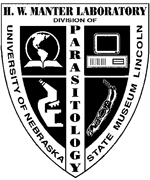Parasitology, Harold W. Manter Laboratory of

Harold W. Manter Laboratory of Parasitology: Library Materials
Document Type
Article
Date of this Version
9-3-2019
Citation
Harl et al. Malar J (2019) 18:305 https://doi.org/10.1186/s12936-019-2940-6
Abstract
Background: Plasmodium species feature only four to eight nuclear ribosomal units on different chromosomes, which are assumed to evolve independently according to a birth-and-death model, in which new variants originate by duplication and others are deleted throughout time. Moreover, distinct ribosomal units were shown to be expressed during different developmental stages in the vertebrate and mosquito hosts. Here, the 18S rDNA sequences of 32 species of avian haemosporidian parasites are reported and compared to those of simian and rodent Plasmodium species.
Methods: Almost the entire 18S rDNAs of avian haemosporidians belonging to the genera Plasmodium (7), Haemoproteus (9), and Leucocytozoon (16) were obtained by PCR, molecular cloning, and sequencing ten clones each. Phylogenetic trees were calculated and sequence patterns were analysed and compared to those of simian and rodent malaria species. A section of the mitochondrial CytB was also sequenced.
Results: Sequence patterns in most avian Plasmodium species were similar to those in the mammalian parasites with most species featuring two distinct 18S rDNA sequence clusters. Distinct 18S variants were also found in Haemoproteus tartakovskyi and the three Leucocytozoon species, whereas the other species featured sets of similar haplotypes. The 18S rDNA GC-contents of the Leucocytozoon toddi complex and the subgenus Parahaemoproteus were extremely high with 49.3% and 44.9%, respectively. The 18S sequences of several species from all three genera showed chimeric features, thus indicating recombination.
Conclusion: Gene duplication events leading to two diverged main sequence clusters happened independently in at least six out of seven avian Plasmodium species, thus supporting evolution according to a birth-and-death model like proposed for the ribosomal units of simian and rodent Plasmodium species. Patterns were similar in the 18S rDNAs of the Leucocytozoon toddi complex and Haemoproteus tartakovskyi. However, the 18S rDNAs of the other species seem to evolve in concerted fashion like in most eukaryotes, but the presence of chimeric variants indicates that the ribosomal units rather evolve in a semi-concerted manner. The new data may provide a basis for studies testing whether differential expression of distinct 18S rDNA also occurs in avian Plasmodium species and related haemosporidian parasites.


Comments
Open access.